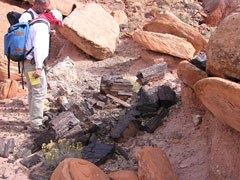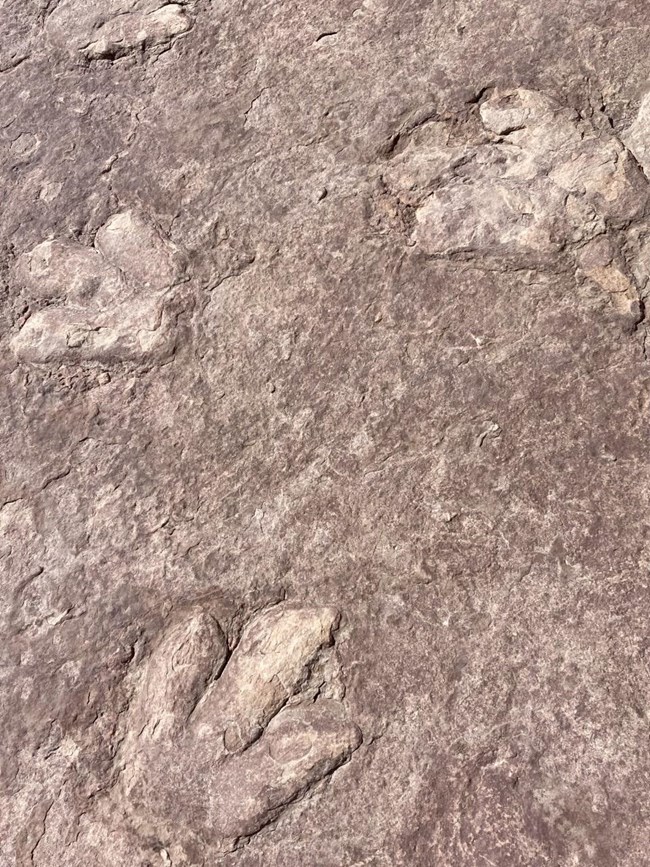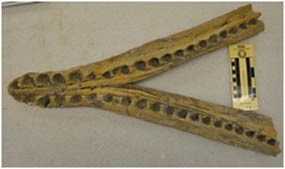
NPS The Colorado Plateau is a vast area that covers approximately 130,000 square miles of Utah, Arizona, Colorado, and New Mexico. In the middle of this rugged landscape lies Glen Canyon National Recreation Area. The Colorado Plateau was one of the last regions in the United States to be thoroughly mapped. Until the construction of the Glen Canyon Dam in the 1960s and subsequent creation of Lake Powell, the central portion of the Colorado Plateau and Glen Canyon was mostly inaccessible. Canyons in this area expose rock layers deposited on top of each other over time; the youngest rocks at the top and oldest at the bottom. These rock formations are storytellers, revealing fossils and traces of past life forms which create chapters of the earth's history. Paleontology, the science that investigates the history of life on Earth, can lead to links in biodiversity and evolutionary relationships that illustrate the changes in the environment and climate. Circumstances and conditions to form fossils are very rare; immediately after a plant or animal dies, it must be covered by sediment which protects it from decay and scavengers. Hard substances like bones, teeth, and shells, are more likely to form fossils than soft tissues. Because of the rare and specific conditions needed to preserve remains, only a few plants or animals are likely to become fossilized. Since so few plants or animals are preserved as fossils, fossil records may represent a small portion of previous life. Mesozoic EraScientific and public interest in the Mesozoic Era fossils preserved in the Colorado Plateau region and Glen Canyon NRA has increased due to recent scientific discoveries. The Mesozoic Era began approximately 251 million years ago (mya) at the end of the Paleozoic Era when the area that would eventually be the Colorado Plateau broke free from Pangea, the supercontinent. The Mesozoic is divided into three time periods: Triassic (251-200 mya), Jurassic (200-145 mya), and Cretaceous (145-65 mya). During the Mesozoic, meaning "middle life," dinosaurs evolved and became diverse and the earliest mammals appeared. The fossils preserved from this time record these changes. Triassic PeriodDuring the Early Triassic Period, the climate became warmer and had milder seasonal variation. Large amphibians that reached five to six feet in length swam in slow-moving streams, leaving traces of their forefeet touching the bottom. These swim traces are preserved in the reddish-brown Moenkopi Formation in the Glen Canyon area, the oldest formation of the Triassic Period. Over time, the environment became subtropical and seasonally humid. Abundant vegetation including subtropical forests, palms, ferns, and horsetail rush grew along the banks of a vast, muddy river system that later formed shale. Later, giant coniferous trees reached over 150 feet in height and now appear in the Chinle Formation as petrified wood. Vertebrate tracks and bones, including bones from a fish, have also been found in the Chinle Formation at the park, a formation which can vary from purple to greenish-gray in color. During the Late Triassic Period, dinosaurs and the earliest mammals began to appear. These early mammals were about the size of a shrew (approximately two to five inches in length) and left rodent-like tracks. Dinosaurs preyed upon these early mammal populations. 
NPS/ Kelsey Shores Jurassic PeriodDinosaurs evolved as the climate changed and were common by the Jurassic Period. Sandstone created by the ancient sand dunes of Jurassic deserts preserves dinosaur tracks. Tracks of theropods, large carnivorous dinosaurs, are found in the Wingate Sandstone, Kayenta Formation, and Navajo Sandstone. Several known track sites have been covered by the water of Lake Powell. Footprints with skin impressions from sauropods, dinosaurs with long necks and tails, have been found in the Summerville and Morrison Formations near Lake Powell. Sauropods were widespread from the Early Jurassic Period to Late Cretaceous Period. By the Late Jurassic Period, dinosaurs evolved to massive sizes and were high in numbers and diversity. Mammals also began to diversify, though they were still small in size. Other animals that flourished during this time include freshwater clams, turtles, fish, snails, salamanders, frogs, lizards, crocodiles, and insects. Fossilized termite nests have been documented in the Morrison Formation at Glen Canyon. 
NPS Cretaceous PeriodAfter a 100 million years, the Jurassic climate changed to swampy riverside and costal habitat; the inland Western Interior Seaway brought a large body of water back to the area. During this Late Cretaceous Period, streams and shorelines deposited materials, eventually forming the Dakota Formation composed of sandy conglomerate, sandstone, and shale, with minor coal deposits. Fossil oysters and bivalve mollusks have been found at the top of the Dakota Formation in the Glen Canyon area. Skeletons of plesiosaurs, carnivorous aquatic reptiles, have been found in the Tropic Shale of the park. Other marine life finds include teeth from an extinct skate (a fish related to sharks and rays), a few unidentified shark teeth, and a variety of marine invertebrates. During the Cretaceous Period, vegetation communities changed and the first flowering plants (angiosperms) appeared, eventually comprising about 90% of plants in the world. Over time, the climate became warm, subtropical to tropical, and vegetation began to resemble modern plants, providing new food sources and habitats. Mammals, amphibians, reptiles, and fish continued to diversify. True birds appeared and coexisted with bird-like dinosaurs. Descendents of many of these animals exist today. At the end of the Cretaceous Period, around 65 mya, approximately 50% of the marine and terrestrial vertebrates became extinct in a short time, ending the roughly 150 million years of dominance by dinosaurs. Nearly 80% of plants did not survive. The cause of this extinction was likely an asteroid impact in the Yucatán Peninsula and climate change caused by an unknown factor. Fossil DiscoveryFossils preserved in the rocks of Glen Canyon are evidence of the life and changes that occurred during the Mesozoic Era. The discovery of new fossils adds to our understanding of biodiversity during this period and evolutionary history. It is exciting to find a fossil, but important to protect it. If you find a fossil in a park, leave the fossil where it is, take a photo and share your discovery with a park ranger. Removing fossils from the sites where they were found will result in most of the interesting and valuable information about fossils being lost forever. It is illegal to collect fossils in National Park Service areas without a permit. Never make molds or castings, or apply anything to fossils and trackways. Such practices can permanently damage paleontological resources. Thank you for helping the National Park Service preserve and protect these resources for future generations. Dinosaur tracks can be viewed at the Carl Hayden Visitor Center, Navajo Bridge Interpretive Center, and the Wahweap District Ranger Office.
|
Last updated: October 30, 2023
